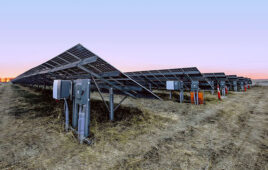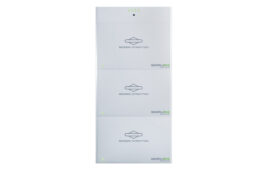
Oliver Koehler, CEO and founder, SunTegra
Solar shingles are a great option for installers seeking a sleek, integrated way to produce PV energy on residential roofs. Still, the technology hasn’t caught on quite like solar panels mounted to rails. We interviewed Oliver Koehler, CEO and founder of SunTegra, to learn more about his company’s solar shingles, including the power they produce, how they’re warrantied and what are the steps to installation.
Solar Power World: Dow Powerhouse announced it was leaving the solar shingle in July. They were a market leader, and chatter suggests the company’s exit is a setback for the solar shingle industry. What’s your take?
Koehler: I don’t think this is really a setback for the solar shingle market as some industry publications have portrayed. I think this is more a setback for the CIGS thin-film technology, which was the basis of the Dow Powerhouse Shingle. The thin-film technology made the product too expensive and less efficient compared to standard rack-mounted solar panels. This, in turn, made the available market too small to support the huge scale required to make the technology cost-competitive. Our strategy is different. We base our products on standard crystalline solar cell technology, which enables us to tap into the industry’s existing economies of scale and provide a competitive cost and similar efficiencies and reliability to standard solar panels.
Dow gave it a good shot, but I believe they were still a long way away from profitability, and the Dow and DuPont merger pushed management to shut it down.
That said, Dow did a good job developing customers for their products. These are customers that SunTegra today is very focused on serving and we are already in touch with many of them.
You’ve partnered with a number of home construction firms as a key way to distribute your product. Are you equally interested in partnering with solar installation firms, and how can they get involved?
Our SunTegra Shingle and Tile products replace asphalt shingle or tile roofing materials and thus are best to install with a new roof, construction or remodeling project. For this reason, our typical customers are roofing companies, home builders and home improvement contractors. For these companies it is easy to insert our SunTegra products into their business and sales processes.
We also sell to traditional solar installation firms who see the value in offering a differentiated roof-integrated product in addition to their standard rack-mounted solar panels. The SunTegra Shingle or Tile helps them capture customers who like the low-profile look of an integrated system and/or want to capitalize on savings when they have need to reroof anyway before adding solar.
For solar installers who may be interested in a solar shingle product but are unsure about the process of installing them, can you offer a brief step-by-step?
Installing SunTegra products is similar to installing both roofing material and standard solar panels. Our SunTegra Shingle and SunTegra Tile systems are attached directly to the roof deck in an overlapping fashion with screws. This means you don’t have to find rafters and can skip installing footings and rails.
Because the panels overlap and are only installed on sloped roofs, the attachment points to the roof deck are protected from the weather. For the SunTegra Shingle system, perimeter flashings enable integration with the surrounding asphalt shingle roofing materials. SunTegra Tiles integrate directly with standard flat concrete roofing tiles.
Electrically, individual solar shingles or tiles are attached to each other through MC4 connectors, just as with standard solar panels. The panels are designed with enough space underneath for home-run cables. Typically, the strings from the solar array are terminated through the roof into the attic where the electrician can then run standard conduit down to the inverter.
Let’s talk about efficiency in terms of shingle size and power production. How much power does a single SunTegra solar roof shingle system produce, and how big is that shingle?
Our SunTegra Shingle and Tile products are the most powerful in their class and have similar efficiencies to a black 260 to 270 watt 60-cell solar panel. Our SunTegra Shingle is rated at 100 watts. It’s about 2 ft. × 4 ft. and has a rated efficiency of up to 15.1%. SunTegra Tile is rated at 67 watts, is about 1.5 ft. × 4 ft., and has a rated efficiency of up to 14.5%.
As far as energy production on a roof, SunTegra’s patented TegraVent design promotes ventilation, which reduces heat throughout the system and enables superior energy performance relative to other integrated solar products.
Rail-based solar systems are expected to last the lifetime of a roof, if not longer. What kind of warranty or guarantee does SunTegra offer its consumers?
Since SunTegra products use similar materials to standard solar panels, they have a similar expected lifetime and warranty. We offer a 20- to 25-year power guarantee and a 10-year product guarantee.
That brings up an important issue. When it comes to asphalt shingle roofs, the lifetime of the solar system will exceed the lifetime of the roof, which is typically 20 to 25 years. This means that a standard rack-mounted solar array will have to be removed and then replaced in order to enable a roofer to reroof the area where the solar array was installed—a future cost that can be $2,000 or more which most system owners don’t anticipate. With a roof-integrated system, the solar array can be left in place which saves money by not having to reroof under the panels.
How can solar installers design these systems for various roof types? Is there software available to help with the design process?
Many of the software tools that installers use for conventional solar panels can be used for SunTegra products as well, including design tools like QuickSolar or Aurora, and inverter string sizing tools offered by vendors like SMA.
We also offer complete design services including preliminary designs, full design packages, rebate and interconnection assistance if needed. We can ship complete kitted systems, which provide everything needed for an installation, other than standard roofing materials and fasteners which are easy to source locally. That said, many solar integrators prefer to only buy the SunTegra solar shingles or tiles with some unique accessories to accommodate those who are interested in carrying the product and committing to volume targets.
Finally, how can solar installers learn more about your product?
Our website at www.suntegrasolar.com carries a lot of product collateral including images and great technical information. Companies interested in becoming a SunTegra dealer can fill out an information form on our website so that we can best review their potential for a strong working relationship.





From the article, it sounds like these panels are designed to be connected in strings, using a central inverter. Is there room to include distributed electronics? Without the ability to use micro inverters or optimizers, this installation method will not comply with the intent of the new NEC codes and will also prevent panel level monitoring.